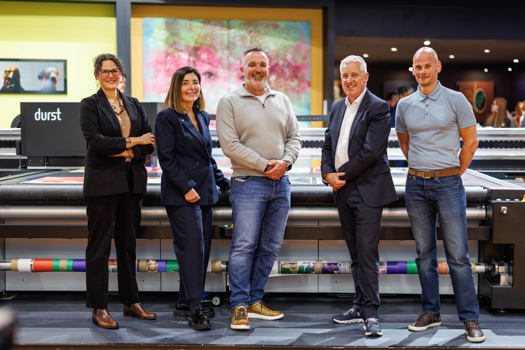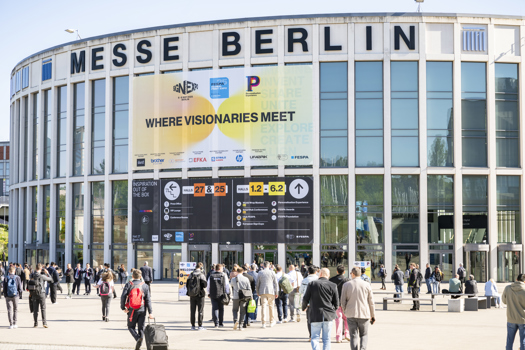Hazards, opportunities, sources of sustenance, potential partners, and resources that can be exploited are all drawn into sharp relief through nature’s deployment of colour.
As technologies have developed, so colour has become increasingly important. Think what colour television did for the world of snooker, and how the analysis of the spectrum allowed mankind to understand if stars are moving toward or away from Earth.
Colour is everywhere, and it’s used by organisations to publicise whatever it is they seek to promote. Colour is big business and used creatively, it can make the difference between achieving success or languishing in a backwater. Good use of colour requires an understanding of psychology and perception – and today’s multimedia world.
Being read receptively
Alison Rodwell, colour trend expert at papermaker James Cropper, considers colour and its use to be central to an identity – “it’s one of the biggest signposts for a brand”. But she says that successfully engaging consumers involves more than just colour, as other factors play a part in promotion too, particularly packaging.
She explains: “When a consumer interacts with a brand through its packaging, the tangible experience is crucial. Every moment during that unboxing event is an opportunity to validate the brand experience. Texture, weight and even sound come into play.”
For her, it is the combination of colour and the paper selected that determines the message an organisation portrays and how consumers respond. She says, for example, that “environmental and sustainable marketing materials can lean towards a particular base stock. So, to offer genuine sustainability credentials throughout, brands need to consider their ink selection and provenance”. She’s referring here to natural dyes, water-based inks, mineral oil-free print, vegan inks and so on.
But if an organisation wants to portray luxury, Rodwell recommends that “a higher quality of paper with a distinct look or feel is chosen, and foil printing or embellishments are used to create a more opulent finish”. The quality of the print is also important, as that influences how the material is perceived, she point out. “Print is very dependent on the paper used and its printing specifications.”
Leatrice Eiseman, executive director of the Pantone Color Institute and director of the Eiseman Center for Color Information & Training, also believes the situation is complex. She says there are no magic-bullet answers to promotional success. “Yes, paper, card stock and design all play into the final product and the perception of what the product or project can promise, but all colours in messages must be thought of in terms of context: how and where it is used, who the target audience is, who the competition is and the colours they are using.” Copying a rival’s message isn’t always a smart idea.
From an artist’s perspective, Stuart Semple takes a different approach. He seeks to “have a conversation with the audience” and looks to convey meaning in his work. He too thinks that “if you want to communicate well, it’s about the whole package; the image, the language, colours and fonts”. He says: “I experiment a lot with different paper and stock when I make print work, and that level of tactility can add a whole new dimension to the work.”
For him, “design is a whole package that needs to be in service of the idea and put the audience at the centre”. He believes “colour is useful, but it’s wider than that... I’ve seen monochromatic work that speaks volumes”.
And he’s right – we only have to look at the 2004 black-and-white tonal image – ‘Equanimity’ – of Queen Elizabeth II taken by Chris Levine. Alternatively, look at Schindler’s List, a film about a young child caught up in the Nazi maelstrom, which was shot in black and white but emphasised a single colour – red.
Colours matter
While we all perceive and value colours differently, subtleties in tone can make a big difference. In Rodwell’s view, duller or brighter versions of a colour and how they are used play a significant part in perception. That said, she believes the matter isn’t always a straightforward as aligning a colour to a particular sector. “Look at T-Mobile, for example. It stands out in the tech sector with its pink branding – a shade consumers would traditionally expect to see in the beauty and cosmetics industry.”
Then there is blue, a colour Rodwell says expresses “stability and trust, which align with its use by pharmaceutical brands and the banking sector”.
Eiseman thinks the same, noting that “blue is well understood to represent quality, integrity, honesty, constancy and other positive connotations”. She adds: “This could work for many types of businesses and such where that message is essential to get across. It doesn’t ‘belong’ to any one sector.”
She adds that other sympathies come into play within each sector when using a colour, not the least of which is what competitors are using. It is also a matter of what shade of the colour family is used: “An electric blue will add more excitement and energy to the message, as well as the other hues combined with the major colour.”
It’s a point that Rodwell reinforces when she says that “brighter colours like orange, yellow and red stand out and are often used by brands that seek to create a sense of excitement. But bright colours are not often associated with luxury brands; they often play off black and white combined with silver or gold print. However, Louis Vuitton stands out from the rest with bold orange packaging that is linked to its heritage”.
And then there’s the matter of age of target customers. Here Rodwell comments that “with an older demographic drawn more to neutrals and trustworthy classic colours, and the younger generation attracted to bright, contrasting colours and energetic shades, in today’s world there may be an opportunity for colour to offer the scope for generational marketing”.
White is seen as a clean or even clinical colour – it’s a reason why Boots uses it with blue for its branding. Rodwell expands on this, noting that it “is used in packaging to signify purity, and as a blank canvas for ease of printing”.
But for Semple, the key to using colour is to understand that over time it can become associated with certain organisations. He comments that “some colours feel more serious, and others more youthful or vibrant and exciting. A neon-pink logo for a brain surgeon might not feel safe. Whereas a navy-blue rave might be a bit weird”.
In fact, he’s of the view that “we have certain socially constructed connotations around colours”, which is why green feels environmental and black feels like luxury and high fashion. In other words, we are programmed to respond in certain ways to different colours.
The importance of choosing correctly
As any marketer will state, the choice of a colour – and for Rodwell, materials – must align with the brand’s overall intended image and messaging. Here Rodwell emphasises that “if a brand wants to convey better environmental messaging then increasing the amount of recycled content, above what’s legally enforced, into packaging and moving away from fossil-based materials is important.”
Eiseman too is clear that from the outset it is critical that “the message comes largely from the chosen colour or colours. Form, shape, style all enter into the attraction, but colour is the main attractor”.
And Semple agrees: “I think the colour we use is really important, but it all depends on what you are making and what you are trying to convey.” He says most of what he does is linked to sentiments, so he’s “thinking about the emotional layer of work and perhaps what colours play into that… the sense I am trying to convey overall”. He notes that colour palettes can be, for instance, nostalgic, current, historic, muted or high-energy.
But just as it’s important to choose colour from the outset, Rodwell says packaging design is also important, as is the ease of recycling. “We recently worked with champagne brand Perrier-Jouët and designed a packaging wrap that is 93% lighter than its predecessor. Being more sustainable was the brief from the outset, so the material composition was crucial,” she says.
Naturally, brands evolve and new firms don’t always get branding right the first time; the BBC’s Dragons’ Den often sees branding pulled apart.
Change what works?
To reiterate, Rodwell believes colour plays a crucial role in the packaging design process. “Colour,” she says, “grabs attention, provokes emotions and creates brand recognition; and directly affects the purchasing decision. It’s reported that 85% of consumers buy products based on colour.” She feels changing a brand’s colour that is already in use requires a very good reason to make a course correction.
Indeed, change can be reviled. Aviation fans may remember the failed attempt in 1997 by British Airways to enhance its world brand credentials with ethnic liveries. It was vilified by Margaret Thatcher and used by rival Virgin Atlantic as an excuse to apply the union flag to its aircraft. Needless to say, heads rolled and by 2001 a new CEO said the programme would end and the union flag would return. And then there’s the example of Royal Mail being rebranded as Consignia in 2001 at a cost of £1.5m. The name, logo and colours meant nothing to anyone outside the company and, about a year later, it spent £1m to go back to using Royal Mail.
In Rodwell’s view, change is all about reason: “If change is prompted to achieve a strategic objective of attracting new audiences and changing perception of the brand, it can work. But, if the brand is stable and performing, changing a well-known colour could be risky. Why fix something that isn’t broken?”
That said, she believes colour changes can be subtle and notes that Burberry swapped from a beige shade that matched the fabric colour of its iconic trench coat to a warmer honey shade. “While this was a change in colour, it was a colour change within a brown and neutral palette.”
She gives another, more recent, example – Swarovski – and tells how the brand moved from a dark blue hue to a range of bright-coloured packaging in white, pink, yellow, blue and green. “This total brand refresh,” Rodwell comments, “the first in 32 years, was born from the vision of their new creative director to shine a light on the fundamental material of crystal and bring that to life in stores, digital and packaging.”
Semple thinks the same, that change is possible. He says that “the point of a brand is to hold meaning... it’s a container, so it’s easy for a brand to change what it stands for without shifting the identity”. He gives an example of what he means – Burger King shifted its look to play with a retro nostalgia, but “that was way more to do with a ‘juicy’ font choice rather than a colour shift”.
Overall, Semple feels if a logotype is established enough it could easily change colour. He points out that Apple did precisely that when it released different colourways on its 24-inch iMacs – “it produced the Apple logo in loads of colours and nothing was lost; it just showed it was playful”.
So, Semple reckons that the colour of a logotype isn’t that vital if the identity itself is strong and established. However, he says that in the early days of a brand colour really does matter – “a bright pink Nike swoosh would still read as Nike, but it would convey a meaning beyond that”.
Eiseman, alternatively, suggests that there is no hard-and-fast rule when it comes to changing what works. In fact, she thinks that sometimes change is good to modernise and update. However, she warns that there is always the consideration of ‘brand equity’ and what positive associations are tied up with the colours of the brand. “For our clients,” she says, “I often recommend a refresh where the intensity or vibrancy of a given colour can be tweaked so that the main colour family is still apparent, but a different shade or tint of the colour is somewhat altered or a new colour is introduced into the mix.”
The point is quite clear – successful change requires a good back story, such as a nod to a brand’s history rather than the removal of everything that had been before.
The rebranding of Cardiff City Football Club – the Bluebirds – is an example of what not to do. It formerly had a virtually all-blue logo, but on buying the club in 2010, Vincent Tan decided to change the kit from blue to red, along with replacing the blue bird on the logo with a red dragon. It’s reckoned that Tan spent an estimated £100m on the rebrand, which did little for the faith and trust from fans. By 2015 the logo was back to blue.
Protecting brand colours
The natural question to ask is whether a brand’s colours can be trademarked. Possibly, but not in all circumstances. Eiseman acknowledges that there is some controversy about whether or not a colour can be owned. However, she points out there is often “so much equity and effort that is built into the branding, therefore some kind of protection is a major factor.”
In the UK, generally the courts have taken the position that consumers are not accustomed to perceiving colours as trademarks – that is, they may not perceive a colour as a sign that designates the origin of the goods or services of a particular undertaking. As a result, it can be difficult to prove that a colour or combination is distinctive in relation to the goods and/or services on which it is used. That said, as this issue went to press Lidl had just won a trademark battle with Tesco over the latter’s use of a yellow circle on blue square. Tesco plans to appeal.
From Rodwell’s standpoint, while colours can certainly define a brand, from Louboutin’s red soles to the sought- after Tiffany blue jewellery boxes, “the legal position on trademarking colour is a grey area”.
And from the perspective of a free-thinker, Semple is vehemently against colour being trademark. Apart from saying that “protecting a colour isn’t important”, he believes trademarking colour “is immoral and awful”. He also says there is no need to protect a colour because of existing usage: “Barbie already has the pink association and Tiffany the blue. So there is no need to add a layer of legality to the use of colour, because colour is for expression.”
Ultimately, Semple strongly believes that “nature made colours first; there’s nothing new under the sun and registering and controlling colour is wrong”.
Summary
There’s no doubt that colour plays a central role in our very existence and in how our day-to-day lives play out. Those wanting to boost their chances need to step carefully and choose colours – and products upon which the colour will sit – well. Equally, changes to existing usage need to be evolutionary at best. Revolutions rarely work out well.










